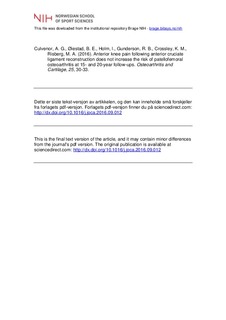| dc.contributor.author | Culvenor, Adam G. | |
| dc.contributor.author | Øiestad, Britt Elin | |
| dc.contributor.author | Holm, Inger | |
| dc.contributor.author | Gunderson, Ragnhild B. | |
| dc.contributor.author | Crossley, Kay M. | |
| dc.contributor.author | Risberg, May Arna | |
| dc.date.accessioned | 2018-01-31T09:08:01Z | |
| dc.date.available | 2018-01-31T09:08:01Z | |
| dc.date.issued | 2016-09-30 | |
| dc.identifier.citation | Osteoarthritis and Cartilage. 2016, 25, 30-33 | nb_NO |
| dc.identifier.uri | http://hdl.handle.net/11250/2480852 | |
| dc.description | I Brage finner du siste tekst-versjon av artikkelen, og den kan inneholde ubetydelige forskjeller fra forlagets pdf-versjon. Forlagets pdf-versjon finner du på sciencedirect.com / In Brage you'll find the final text version of the article, and it may contain insignificant differences from the journal's pdf version. The definitive version is available at sciencedirect.com | nb_NO |
| dc.description.abstract | Objective: To prospectively evaluate the relationship between the presence or persistence of anterior knee pain (AKP) during the first 2-years following anterior cruciate ligament reconstruction (ACLR) and patellofemoral osteoarthritis (PFOA) at 15- and 20-years. Design: This study was ancillary to a long-term prospective cohort study of 221 participants following bone-patellar-tendon-bone ACLR. AKP was assessed at 1- and 2-years post-ACLR using part of the Cincinnati knee score with an additional pain location question (persistence defined as presence at both follow-ups). Radiographic PFOA (definite patellofemoral osteophyte) and symptomatic PFOA (patellofemoral osteophyte, with knee pain during past 4 weeks) was assessed at 15- and 20-years follow-up. We used generalized linear models with Poisson regression to assess the relationship between AKP and PFOA. Results: Of the 181 participants (82%) who were assessed at 15-years post-ACLR (age 39 ± 9 years; 42% female), 36 (24%) and 33 (22%) had AKP at 1- and 2-years, respectively, while 14 (8%) reported persistent AKP. Radiographic and symptomatic PFOA was observed at 15-years in 130 (72%) and 70 (39%) participants, respectively, and at 20-years in 115 (80%) and 60 (42%) participants, respectively. Neither the presence nor persistence of AKP at 1- and/or 2-years post-ACLR was associated with significantly higher risk of radiographic or symptomatic PFOA at 15- or 20-years (risk ratios <2.1). Conclusions: Although AKP and PFOA were prevalent, AKP does not appear to be associated with long-term PFOA following ACLR. | nb_NO |
| dc.language.iso | eng | nb_NO |
| dc.publisher | Elsevier | nb_NO |
| dc.subject | anterior cruciate ligament | nb_NO |
| dc.subject | anterior knee pain | nb_NO |
| dc.subject | patellofemoral joint | nb_NO |
| dc.subject | osteoarthritis | nb_NO |
| dc.title | Anterior knee pain following anterior cruciate ligament reconstruction does not increase the risk of patellofemoral osteoarthritis at 15- and 20-year follow-ups | nb_NO |
| dc.type | Journal article | nb_NO |
| dc.type | Peer reviewed | nb_NO |
| dc.description.version | acceptedVersion | nb_NO |
| dc.rights.holder | © 2016 Osteoarthritis Research Society International. Published by Elsevier Ltd. All rights reserved. | nb_NO |
| dc.source.journal | Osteoarthritis and Cartilage | nb_NO |
| dc.identifier.doi | 10.1016/j.joca.2016.09.012 | |
| dc.description.localcode | Seksjon for idrettsmedisinske fag / Department of Sport Medicine | nb_NO |
